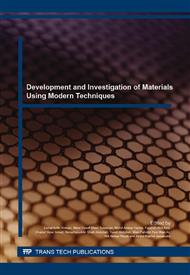p.82
p.87
p.91
p.97
p.103
p.108
p.112
p.118
p.124
Effect of Alkaline Treatment on Sawdust Reinforced High Density Polyethylene Composite under Wide Strain Rate
Abstract:
In this study, the alkali treatment of sawdust using different concentration of sodium hydroxide (NaOH) is performed. The purpose of this treatment is to improve the filler-matrix compatibility, thus, enhance the properties of tested specimens under various strain rate condition. The outcome shows the alkali treated sawdust did improve its surface roughness through reduction of sawdust diameter. With this increasing of surface roughness, it will enhance the compatibility between sawdust filler and HDPE matrix. For comparison purpose, the treated and untreated sawdust filler were reinforce in High Density Polyethylene (HDPE) matrix and have been test under static and dynamic loading using Universal Testing Machine (UTM) and Split Hopkinson Pressure Bar (SHPB) apparatus. The results indicate that the stiffness and compression strength properties were improved on treated sawdust composites for both static and dynamic loading compare to untreated sawdust composites.
Info:
Periodical:
Pages:
103-107
Citation:
Online since:
January 2016
Price:
Сopyright:
© 2016 Trans Tech Publications Ltd. All Rights Reserved
Share:
Citation:


